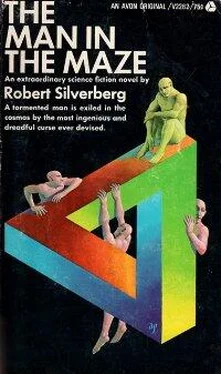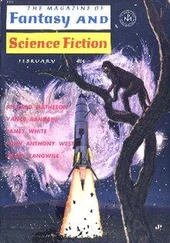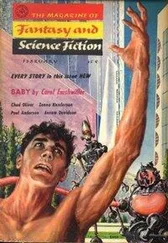Who were these intruders, then?
Archaeologists, he suspected. The ruined city of Lemnos still held a magnetic, fatal fascination for them—for everyone. Muller had hoped that the risks of the maze would continue to keep men away. It had been discovered over a century earlier, but before his arrival there had been a period of many years in which Lemnos was shunned. For good reason: Muller had many times seen the corpses of those who had tried and failed to enter the maze. He himself had come here partly out of a suicidal wish to join the roster of victims, partly out of overriding curiosity to get within and solve the secret of the labyrinth, and partly out of the knowledge that if he did penetrate he was not likely to suffer many invasions of his privacy. Now he was within; but intruders had come.
They will not enter, Muller told himself.
Snugly established at the core of the maze, he had command of enough sensing devices to follow, however vaguely, the progress of any living creatures outside. Thus he could trace the wanderings from zone to zone of the animals that were his prey, and also those of the great beasts who offered danger. To a limited degree he could control the snares of the maze, which normally were nothing more than passive traps but which could be employed aggressively, under the right conditions, against some enemy. More than once Muller had dumped an elephantine carnivore into a subterranean pit as it charged inward through Zone D. He asked himself if he would use those defenses against human beings if they penetrated that far, and had no answer. He did not really hate his own species; he just preferred to be left alone, in what passed for peace.
He eyed the screens. He occupied a squat hexagonal cell—apparently one of the housing units in the inner city—which was equipped with a wall of viewing tanks. It had taken him more than a year to find out which parts of the maze corresponded to the images on the screens; but by patiently posting markers he had matched the dim images to the glossy reality. The six lowest screens along the wall showed him pictures of areas in Zones A through F; the cameras, or whatever they were, swiveled through 180° arcs, enabling the hidden mysterious eyes to patrol the entire region around each of the zone entrances. Since only one entrance provided safe access to the zone within, all others being lethal, the screens effectively allowed Muller to watch the inward progress of any prowler. It did not matter what was taking place at any of the false entrances. Those who persisted there would die.
Screens seven through ten, in the upper bank, relayed images that apparently came from Zones G and H, the outermost, largest and deadliest zones of the maze. Muller had not wanted to go to the trouble of returning to those zones to check his theory in detail; he was satisfied that the screens were pickups from points in the outer zones, and it was not worth risking those zones again to find out more accurately where the pickups were mounted. As for the eleventh and twelfth screens, they obviously showed views of the plain outside the maze altogether—the plain now occupied by a newly-arrived starship from Earth.
Few of the other devices left by the ancient builders of the maze were as informative. Mounted on a dais in the center of the city’s central plaza, shielded by a crystal vault, was a twelve-sided stone the color of ruby, in whose depths a mechanism like an intricate shutter ticked and pulsed. Muller suspected it was some sort of clock, keyed to a nuclear oscillation and sounding out the units of time its makers employed. Periodically the stone underwent temporary changes: its face turned cloudy, deepened in hue to blue or even black, swung on its mounting. Muller’s careful record-keeping had not yet told him the meaning of those changes. He could not even analyze the periodicity. The metamorphoses were not random, but the pattern they followed was beyond his comprehension.
At the eight corners of the plaza were metallic spikes, smoothly tapering to heights of some twenty feet. Throughout the cycle of the year these spikes revolved, so they were calendars, it seemed, moving on hidden bearings. Muller knew that they made one complete revolution in each thirty-month turning of Lemnos about its somber orange primary, but he suspected some deeper purpose for these gleaming pylons. Searching for it occupied much of his time.
Spaced neatly in the streets of Zone A were cages with bars hewn from an alabaster-like rock. Muller could see no way of opening these cages; yet twice during his years here he had awakened to find the bars withdrawn into the stone pavement, and the cages gaping wide. The first time they had remained open for three days; then the bars had returned to their positions while he slept, sliding into place and showing no seam where they could have parted. When the cages opened again, a few years later, Muller watched them constantly to find the secret of their mechanism. But on the fourth night he dozed just long enough to miss the closing again.
Equally mysterious was the aqueduct. Around the length of Zone B ran a closed trough, perhaps of onyx, with angular spigots placed at fifty-meter intervals. When any sort of vessel, even a cupped hand, was placed beneath a spigot it yielded pure water. But when he attempted to poke a finger into one of the spigots he found no opening, nor could he see any even while the water was coming forth; it was as though the fluid issued through a permeable plug of stone, and Muller found it hard to accept that. He welcomed the water, though.
It surprised him that so much of the city should have survived. Archaeologists had concluded, from a study of the artifacts and skeletons found on Lemnos outside the maze, that there had been no intelligent life here for upward of a million years—perhaps five or six million. Muller was only an amateur archaeologist, but he had had enough field experience to know the effects of the passing of time. The fossils in the plain were clearly ancient, and the stratification of the city’s outer walls showed that the labyrinth was contemporary with those fossils.
Yet most of the city, supposedly built before the evolution of mankind on Earth, appeared untouched by the ages. The dry weather could account in part for that; there were no storms here, and rain had not fallen since Muller’s arrival. But wind and windblown sand could carve walls and pavements over a million years, and there was no sign of such carving here. Nor had sand accumulated in the open streets of the city. Muller knew why. Hidden pumps collected all debris, keeping everything spotless. He had gathered handfuls of soil from the garden plots, scattering little trails here and there. Within minutes the driblets of soil had begun to slither across the polished pavement, vanishing into slots that opened briefly and closed again at the intersection of buildings and ground.
Evidently beneath the city lay a network of inconceivable machinery—imperishable caretaker devices that guarded the city against the tooth of time. Muller had not been able to reach that network, though. He lacked the equipment for breaching the pavement; it seemed invulnerable at all points. With improvised tools he had begun to dig in the garden areas, hoping to reach the sub-city that way, but though he had driven one pit more than a dozen feet and another even deeper he had come upon no signs of anything below but more soil. The hidden guardians had to be there, however: the instruments that operated the viewing tanks, swept the streets, repaired the masonry, and controlled the murderous traps that studded the outer zones of the labyrinth.
It was hard to imagine a race that could build a city of this sort —a city designed to last millions of years. It was harder still to imagine how they could have vanished. Assuming that the fossils found in the burial yards outside the walls were those of the builders—not necessarily a safe assumption—this city had been put together by burly humanoids a meter and a half tall, immensely thick through the chest and shoulders, with long cunning fingers, eight to the hand, and short double-jointed legs.
Читать дальше












